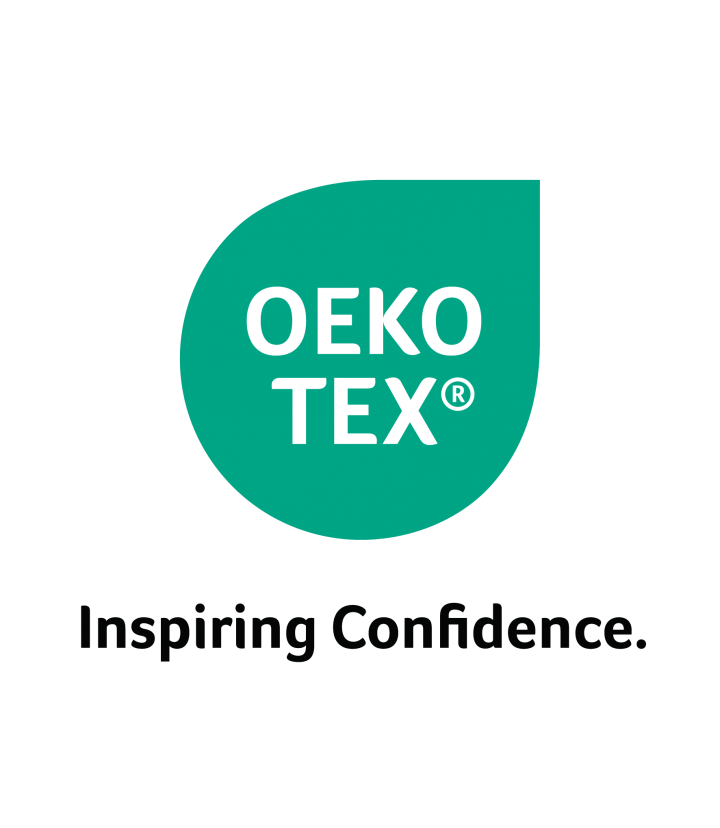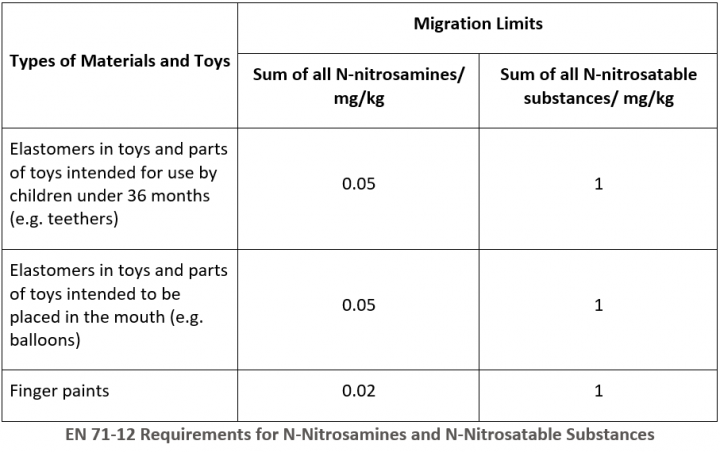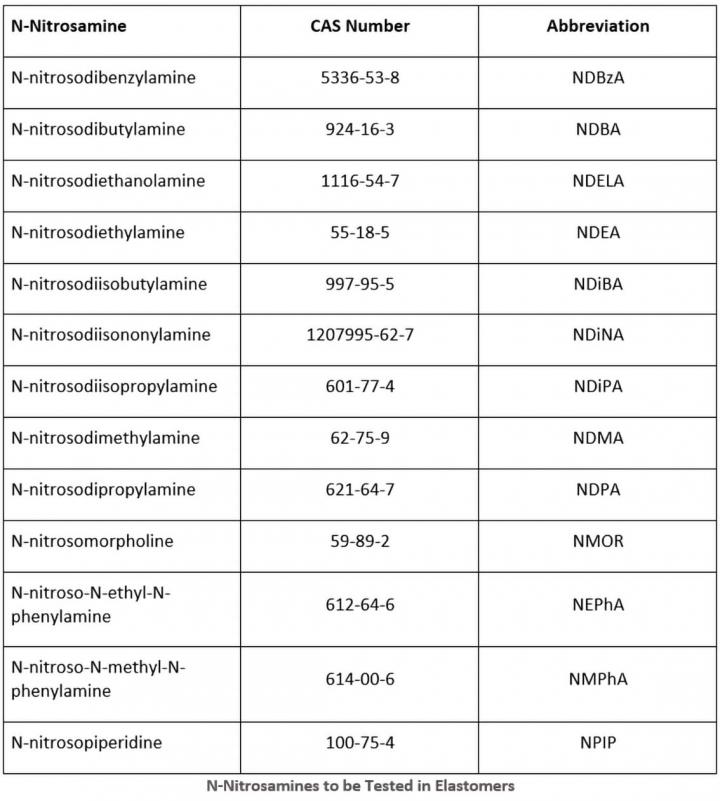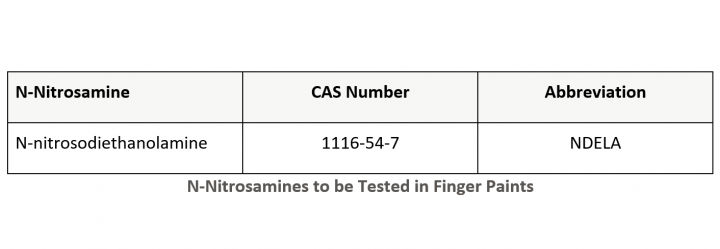Nitrosamines are a group of carcinogenic substances found in various rubber and latex products. Methods exist to extract, concentrate and detect the migration of volatile nitrosamines present in latex gloves and balloons via headspace solid-phase micro-extraction and gas chromatography with mass spectrometer detection.
Most N-nitrosamines have been found to be genotoxic carcinogens in animals and humans. Humans are exposed to the substances through, among others: food, tobacco, cosmetics and all kinds of rubber products (yoga mats). Recently, attention has been focused on migration of nitrosamines from various latex products such as pacifiers, condoms, gloves and balloons.
Nitrosamines enter rubber products during the vulcanization process and migrate to the surface during storage and use.
-
EN12868 - Child use and care articles - Method for determining the release of N-nitrosamines and N-nitrosatable substances from elastomer or rubber teats and soothers - ISO 29941:2010 Condoms - Determination of nitrosamines migrating from natural rubber latex condoms.
EN 71-12:2013 – N-Nitrosamines and N-Nitrosatable Substances in Toys
Toys sold on the EU market must comply with both the Toys Directive and all other applicable EU legislation, such as REACH, CLP, the revised RoHS provisions and persistent organic pollutants (POPs). In addition to the European legislation, there are national regulations, such as the Danish Legal Order 855 of September 5, 2009 on phthalates. On April 1, 2019, the substances have also been added to the requirements of OEKO-TEX®.
EN 71-12 prohibits the use of N-nitrosamines and N-nitrosatable substances in toys intended for use by children under 36 months, in other toys intended to be put in the mouth such as toys made of rubber or elastomers (such as balloons), and in finger paints intended for use by children under 36 months, unless the migration limits
- are lower than 0.05 mg/kg for N-nitrosamines
- are lower than 1 mg/kg for N-nitrosatable substances
EN 71-12 describes test methods to determine N-nitrosamines and N-nitrosatable in certain types of toys.
Elastomers, such as rubber, silicone, and thermoplastic elastomers (TPEs) may contain N-nitrosamines resulting from accelerators, for example. N-nitrosamines in finger paints are formed under certain acidic conditions in the presence of N-nitrosatable substances (e.g., secondary amines) and a nitrosating agent such as nitrite.
EN 71-12 provides test methods in support of the EU requirements for N-nitrosamines and N-nitrosatable substances in certain types of toys. As a reference to this standard has been published in the EU’s Official Journal, compliance will offer a presumption of conformity to the Toys Safety Directive 2009/48/EC.
- Elastomers (e.g. rubbers, silicones, and thermoplastic elastomers (TPEs)) may contain N-nitrosamines, which are believed to arise from precursor additives such as accelerators.
- N-nitrosamines may be formed in finger paints under certain acidic conditions if they include N-nitrosatable substances (e.g. secondary amines) and a nitrosating agent (e.g. nitrite). For example, N-nitrosodiethanolamine (NDELA) can be produced if diethanolamine (DEA, a secondary amine), or even triethanolamine which could decompose to DEA, is present with certain preservatives such as bronopol (nitrite source).
- Some N-nitrosamines are carcinogenic (Category 1B).
The low EN 71-12 limit of 0.02 mg/kg for N-nitrosamines in finger paints takes into account the relatively frequent instances in which certain N-nitrosamines, such as NDELA, are absorbed through the skin, so that it is much more common for the child to absorb NDELA from finger paints through the skin than through the mouth.
Each type of toy material is tested in a different way
- Elastomers are extracted via a nitrite-containing saliva solution because that substance is absorbed primarily through the mouth. The test solution is then divided into a portion for direct analysis of N-nitrosamines, and portion that is acidified to convert the N-nitrosatable substances into further N-nitrosamines.
- Finger paints are extracted by water to extract the N-nitrosamines (simulation of absorption through the skin). The conversion of N-nitrosamines requires acidic conditions (e.g., stomach). Therefore, water is replaced by nitrite-containing saliva.
EN 71-12 requires that elastomers be tested for the presence of N-nitrosamines (13 in total – see table below) that were found in toy materials, along with NDELA in finger paints.
These limits for elastomers are from the Directive and are based on ingestion by mouth.
However the EN 71-12 migration limit for N-nitrosamines in finger paints has been reduced from 0.05 mg/kg in the Directive to 0.02 mg/kg.
This lower limit takes into account the relatively high rate at which some N-nitrosamines, such as NDELA, are absorbed through the skin. Hence the child’s ingestion of NDELA from finger paint is likely to be greater through the skin than by mouth.
The ALARA principle
THE ALARA PRINCIPLE VERSUS THE TECHNOLOGICAL FEASIBILITY OF DETERMINING MINIMUM VALUES
The ALARA principle (As Low As Reasonably Achievable) is used to protect consumers and to minimize the risk of exposure to N-nitrosamines.
According to a January 2011 opinion piece by the German Federal Institute for Risk Assessment (BfR), this ALARA principle should be applied in particular to migration limits for toys made of natural and synthetic rubber that small children (under 36 months of age) can put in their mouths (whether the toy is for that purpose or not). BfR claims that the limits of 0.5 mg of N-nitrosamines per kg of material used by the European Toy Safety Directive 2009/48/EC are too high and were primarily driven by what was technically feasible when determining the limits.
As demonstrated above, Centexbel is capable of detecting chemical substances down to 0.01µ/ml, as a result of which this argument is dropped and the ALARA principle can fully apply.
Test development by Centexbel / OEKO-TEX®

Since 2020, Nitrosamines and N-nitrosatable compounds are included in the OEKO-TEX® test criteria and in the STANDARD 100 by OEKO-TEX® and in the LEATHER STANDARD by OEKO-TEX®.
For this purpose, OEKO-TEX® developed in cooperation with a.o. Centexbel a test method which extracts the nitrosamines and N-nitrosatable compounds from the material and uses for the determination an APPI HPLC-LC/MS/MS technique. This technique allows us to perform trace analysis for these components.







